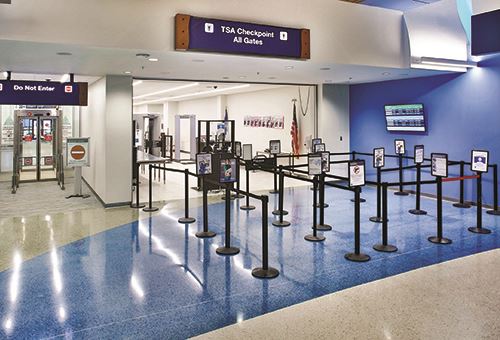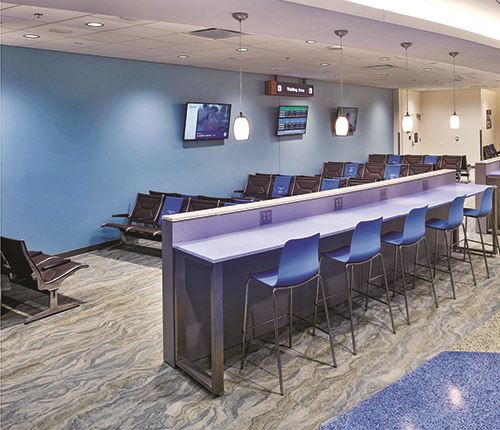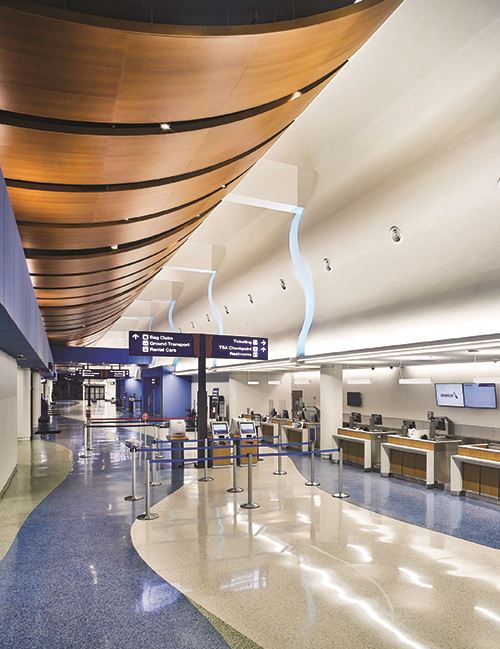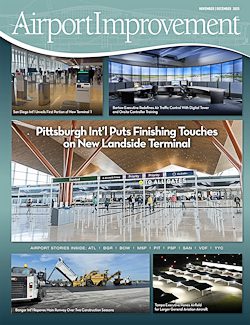If a commercial building fails to keep pace with changes in its industry, it affects everyone who uses it—customers, employees and third-party partners. This is especially true in the ever-evolving airport sector. Columbus Airport (CSG) in western Georgia has lived both sides of that coin. After three decades of continual use and no budget for regular updates, the terminal’s outdated layout and failing infrastructure were negatively impacting everyone’s experience.

If a commercial building fails to keep pace with changes in its industry, it affects everyone who uses it—customers, employees and third-party partners. This is especially true in the ever-evolving airport sector.
Columbus Airport (CSG) in western Georgia has lived both sides of that coin. After three decades of continual use and no budget for regular updates, the terminal’s outdated layout and failing infrastructure were negatively impacting everyone’s experience.
“There were plumbing issues, leaks in the roof, mechanical issues…one of our baggage belts wasn’t even operable,” says Airport Director Amber Clark, thankful that those problems and others are now in the past.
|
facts&figures Project: Terminal Renovations Location: Columbus (GA) Airport Cost: $20.8 million Funding: FAA ($10.9 million); Columbus Airport Commission ($5.5 million); U.S. Dept. of Transportation ($3.3 million); Georgia Dept. of Transportation ($765,300) Construction: March 2020–Oct. 2021 Designer: RS&H General Contractor: Sauer Construction Co. Baggage Consultant: BNP Associates Baggage Handling System Mfg: Automatic Systems Inc. Boarding Bridges: Ameribridge Inc. Exit Breach Control System: FlipFlow Twin (extend model) by Record-USA High-Top Counter Seating: Herman Miller Key Benefits: Update 1991 terminal to accommodate current & future passengers |
Last fall, CSG unveiled a completely renovated terminal that feels like a new airport for passengers and staff alike. The $20.8 million improvement program upgraded the facilities inside and out—from an exterior canopy to new boarding bridges and practically everything in between.
Don Cook, chairman of the Columbus Airport Commission, describes the newly renovated CSG as a “hometown airport that has large airport amenities with a personal touch.”
The comprehensive renovation program that made it all possible was based on a 2017 terminal assessment study that indicated major changes were needed to make CSG a 21st century facility befitting the second-largest city in Georgia. For years, the airport had commercial service from just one commercial carrier, Delta Air Lines. Last fall, however, American Airlines started two daily flights from CSG to Charlotte and daily service to Dallas. Airport officials expect the additional service to increase traffic from 100,000 annual enplanements pre-COVID to somewhere between 150,000 and 175,000 by 2023.
Clark notes that the renovation helped CSG’s effort to recruit American Airlines last year. Airport personnel kept American representatives updated on the project and accommodated the airline’s requests for additional storage space, an additional office and preferences regarding paint and carpeting.
“An airline wants to ensure their customer experience is the best by making sure the terminal ticketing spaces and other accommodations meet their needs,” she elaborates. “They want to work with airports that have the latest technology to help them with on-time performance.”
Good Bones
More passengers amplified the existing need to update CSG’s aging terminal facilities.
“The airport deferred a lot of maintenance on a terminal that was designed when energy was cheap and efficiency didn’t really matter,” explains Brian Thompson, a senior aviation engineer at RS&H, the firm that completed the terminal assessment and served as design builder for the subsequent renovation. “The systems were not right-sized. The building was cold in the winter and hot in the summer due to air leakage.”
 The terminal was designed prior to the era of TSA baggage screening and security checkpoints. Space and equipment for required TSA functions were retrofitted to available space within the terminal, but resulted in poor adjacencies that disrupted daily operations of the terminal. This slowed the flow of baggage and employees operating around these areas.
The terminal was designed prior to the era of TSA baggage screening and security checkpoints. Space and equipment for required TSA functions were retrofitted to available space within the terminal, but resulted in poor adjacencies that disrupted daily operations of the terminal. This slowed the flow of baggage and employees operating around these areas.
The terminal assessment determined that while the facility needed extensive work, the “bones” of the two-story, 71,162-square-foot structure were good. In other words, the footprint of the building still served CSG’s needs for commercial flights and its thriving general aviation traffic.
The design developed by RS&H encompassed a lengthy list of upgrades:
- A remodeled ticketing area is now outfitted with new ticket counters and integrated baggage screening.
- The second floor, which previously served as a boarding area only accessible to screened passengers, was remodeled and converted for use by passengers and visitors alike. The new landside area includes additional seating, along with rocking chairs, a children’s play area and new restrooms.
- The renovated lobby and holdrooms include bar-height counters with seating for guests using laptops.
- The boarding area was moved to the first floor, and two new boarding bridges were added.
- The single-lane TSA checkpoint previously saddled with age-related inefficiencies was relocated and expanded. Passengers now have more room to line up, and there is enough space to add a second screening machine and another belt if passenger growth warrants.
- An automated security breach system with sliding glass doors was installed adjacent to the TSA checkpoint to prevent arriving passengers from re-entering the secure area. Prior to renovations, a member of the CSG Public Safety Department had to manually guard the area anytime the TSA checkpoint was in operation.
- A fully automated baggage handling system now connects the ticketing area to the baggage screening checkpoint. Previously, passengers who checked their bags had to carry them down to a separate door and hand them off to TSA personnel, who then manually fed them through the screening system.
- HVAC, electrical and other mechanical systems were upgraded throughout the terminal, and a designated electrical room was created.
- Aesthetic improvements such as new interior wood finishes and an outdoor landside canopy span the entire facility. The lobby was brightened with natural daylight and more vivid colors.
- Extras added to enhance the traveler experience include new rental car counters, an indoor pet relief area and adult changing stations in pre- and post-security restrooms on the main floor.
A new terminal roof was not part of the original design plans but was added promptly after an early inspection revealed that patching spots where it was leaking would not be practical.

A COVID Silver Lining
Federal grants from the FAA and U.S. Department of Transportation funded more than half of the $20.8 million improvement program. Additional funds came from the Columbus Airport Commission and the Georgia Department of Transportation. (See Facts & Figures section on Page 50 for a detailed breakdown.)
Once airport officials knew they would receive the necessary funds to complete the full range of work, RS&H divided the project into four major phases and mapped out various sub-phases. Work was set to begin in March 2020—exactly the time when COVID-19 interrupted air travel around the world.
With such uncertainty in the air, conversation ensued about whether to proceed. “We discussed delaying the project because we didn’t know if we’d have enough laborers, and we didn’t know what was going to happen financially,” Clark recalls. “We decided to continue with the project, and it was the best decision we ever made.”
 RS&H Project Manager Pete Novak credits the Columbus Airport Commission for keeping the project moving. “Their support of the project and team during this period allowed us to move forward without having to second guess each decision along the way,” Novak explains. “This was critical to the project’s success.”
RS&H Project Manager Pete Novak credits the Columbus Airport Commission for keeping the project moving. “Their support of the project and team during this period allowed us to move forward without having to second guess each decision along the way,” Novak explains. “This was critical to the project’s success.”
The COVID-induced decline in passenger traffic through most of 2020 allowed work crews to tackle more of the project at once and accelerated their progress. Moreover, building materials were still available and ultimately cost significantly less than they would have if the airport delayed starting the project by even one year.
Clark adds that sticking to the original timetable fortuitously put local laborers to work while many other construction projects were on hold. “We were really proud to be able to keep a lot of people employed,” she remarks. “And we never had a COVID outbreak.”
Construction was completed in October 2021.

Reflecting the Community
Airport officials and their project partners are especially proud of the features built into the renovations that reflect the local community. RS&H incorporated elements of the Columbus area’s architectural heritage, geographic characteristics and downtown waterfront into the look and feel of the renovations. Curving walls convey the sense of the winding waters of the Chattahoochee River, which runs along the western edge of Columbus. Exterior touches include brick pavers similar to those found throughout the historic waterfront.
 In a nod to nearby military installations, the entire gate area will be decorated to honor U.S. servicemen and women. Columbus is just 10 miles from Fort Benning, a U.S. Army post that supports more than 120,000 active-duty military, family members and reserve soldiers. As such, a significant percentage of the passengers who fly in and out of CSG are members of the military. Plans for the gate area include dedications to all five branches of the Armed Forces.
In a nod to nearby military installations, the entire gate area will be decorated to honor U.S. servicemen and women. Columbus is just 10 miles from Fort Benning, a U.S. Army post that supports more than 120,000 active-duty military, family members and reserve soldiers. As such, a significant percentage of the passengers who fly in and out of CSG are members of the military. Plans for the gate area include dedications to all five branches of the Armed Forces.
“A critical part of the design process is taking the time to understand the unique qualities that contribute to a sense of place,” said Frank Gratton, RS&H lead design architect. “Those can often be found in the history, culture, people and context of the natural and built environment.”
 Sauer Construction Company hired Ryan Wampler, who has lived in the Columbus area for several years, to lead the CSG project for the general contractor. As a passenger using the local airport to fly to other Sauer jobsites, Wampler notes that the recent aesthetic improvements make a big difference. But his inside knowledge makes him aware that CSG boasts a lot more than just a better look.
Sauer Construction Company hired Ryan Wampler, who has lived in the Columbus area for several years, to lead the CSG project for the general contractor. As a passenger using the local airport to fly to other Sauer jobsites, Wampler notes that the recent aesthetic improvements make a big difference. But his inside knowledge makes him aware that CSG boasts a lot more than just a better look.
“The real benefit of the project is in the internal systems,” he relates. “That’s where the majority of the value comes in. When I was surveying the building and prepping it for construction, the extreme temperatures inside the building were uncomfortable and unbearable for our workers and for passengers. The guts of the building are so much better from a customer comfort standpoint. It’s in a much better place now.”



